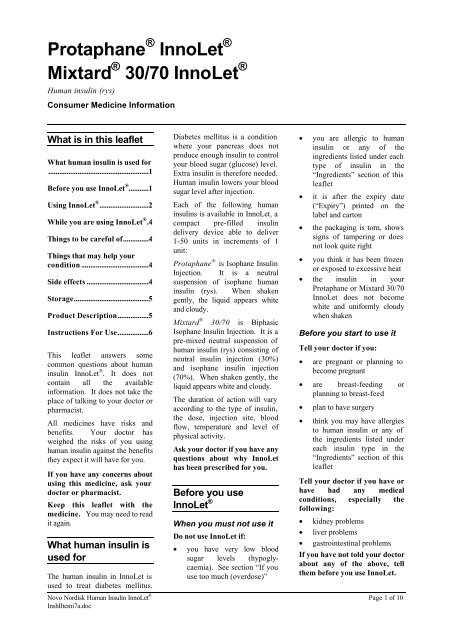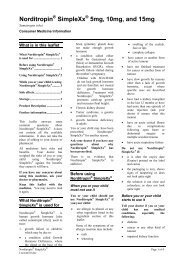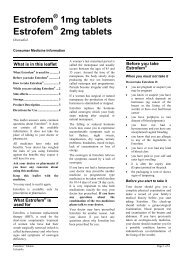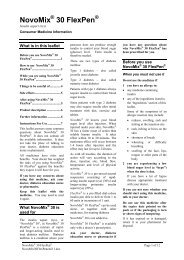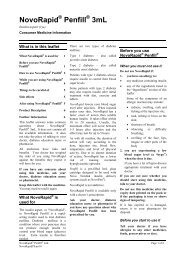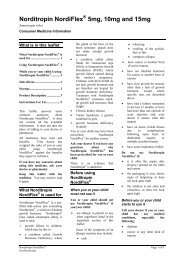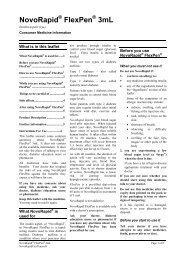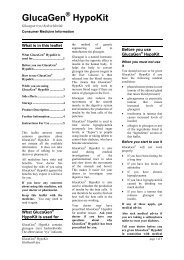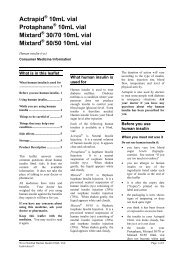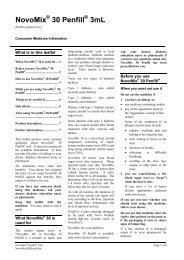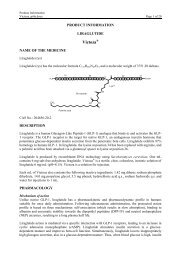Protaphane InnoLet Mixtard 30/70 InnoLet - Novo Nordisk Australasia
Protaphane InnoLet Mixtard 30/70 InnoLet - Novo Nordisk Australasia
Protaphane InnoLet Mixtard 30/70 InnoLet - Novo Nordisk Australasia
- No tags were found...
Create successful ePaper yourself
Turn your PDF publications into a flip-book with our unique Google optimized e-Paper software.
Taking other medicinesYour dose of insulin may need tochange if you take othermedicines. You should tell yourdoctor if you are currently takingany medicines, especially thefollowing:• oral hypoglycaemic agents -used for the treatment ofnon-insulin dependentdiabetes (type 2 diabetes)• monoamine oxidaseinhibitors (MAOI) - used forthe treatment of depression• non-selective beta-blockingagents - used for thetreatment of certain heartconditions and high bloodpressure• alpha-blocking agents - usedfor the treatment of highblood pressure and to relievedifficulty in passing urinecaused by an enlargedprostate• angiotensin convertingenzyme (ACE) inhibitors -used for the treatment ofcertain heart conditions, highblood pressure or elevatedprotein/albumin in the urine• salicylates e.g. aspirin - usedto relieve pain and lowerfever• anabolic steroids andglucocorticoids (excepttopical administration) –used to treat inflammatoryconditions• oral contraceptives (“thepill”) - used for birth control• thiazides, frusemide orethacrynic acid - used for thetreatment of high bloodpressure or fluid retention(oedema)• thyroid hormones - used forthe treatment of malfunctionof the thyroid gland• sympathomimetics - used forthe treatment of asthma• sulphonamides – used totreat bacterial infectionsOr other specific medicinesincluding:• danazol - used to treat certainfemale conditions• oxymetholone – used to treatcertain blood disorders• octreotide - used to treatgastrointestinal endocrinetumours• diazoxide - used for thetreatment of high bloodpressure• nicotinic acid - used for thetreatment of high cholesterollevels in the blood• asparaginase - used to treatleukaemia and lymph glandtumours• quinine – used for theprevention of malaria and therelief of muscle cramps• quinidine – used for thecontrol of heart problems• growth hormone – used totreat persons with growthhormone deficiencyTell your doctor if you aretaking any other medicines,including any that you buywithout a prescription fromyour pharmacy, supermarketor health food shop.Immediately before youuse itMake sure that:• the insulin in your<strong>Protaphane</strong> or <strong>Mixtard</strong> <strong>30</strong>/<strong>70</strong><strong>InnoLet</strong> looks uniformlywhite and cloudy• your <strong>InnoLet</strong> is not damaged<strong>InnoLet</strong> is for use by you alone toavoid the risk of passing ondiseases.Using <strong>InnoLet</strong> ®How to use <strong>InnoLet</strong> ®Carefully follow the advicefrom your doctor and yourdiabetes team regarding typeof insulin, dosage and time ofadministration, blood sugarmonitoring, diet and exercisein order to achieve goodcontrol of your diabetes.Your doctor may also want you touse another insulin.Changing to humaninsulinAn adjustment in dosage may benecessary when a switch is madefrom beef insulin to humaninsulin. If an adjustment isneeded, it may occur with thefirst dose or during the firstseveral weeks or months. Do notchange dosage or preparationexcept on your doctor's advice.A few patients have reported thatafter being transferred to humaninsulin, the early warningsymptoms for hypoglycaemia(low blood glucose) were lesspronounced than they were withanimal source insulins. Thecharacter and intensity of thesewarning symptoms may alsochange during periods of tightblood glucose control, forinstance during intensified insulintreatment.When to use itYour doctor will tell you whenand how often to inject theinsulin. If you are using <strong>Mixtard</strong><strong>30</strong>/<strong>70</strong>, it is recommended thatyou eat a meal or a snackcontaining carbohydrate within <strong>30</strong>minutes of the injection.How much to useYour doctor will tell you howmuch insulin to inject each time.How to use it• <strong>InnoLet</strong> devices are designedto be used with <strong>Novo</strong>Fine ® Sneedles.• Make sure you are using thecorrect type and strength ofinsulin. Carefully follow theinstructions on how to useyour <strong>InnoLet</strong>.<strong>Novo</strong> <strong>Nordisk</strong> Human Insulin <strong>InnoLet</strong> ® Page 2 of 10InshIltcmi7a.doc
• Do not use the residual scaleto measure your dose ofinsulin (see “Instructions ForUse”).• Prime <strong>InnoLet</strong> before eachinjection until a drop ofinsulin appears at the tip ofthe needle. Do not use<strong>InnoLet</strong> if you have to primeit more than 6 times beforethe first injection (see“Instructions For Use”).• You should inject humaninsulin under the skin(subcutaneous injection) asshown to you by your doctoror diabetes educator.• You will feel the effect morequickly if the insulin isinjected into your abdomen;however, you can inject intoyour thigh, buttock or upperarm.• The best place to injectlonger-acting insulin(<strong>Protaphane</strong>) is in the thigh.• Remember to regularlychange your injection site asshown to you by your doctoror diabetes educator.• <strong>Protaphane</strong> and <strong>Mixtard</strong><strong>30</strong>/<strong>70</strong> <strong>InnoLet</strong> are suitableforintramuscularadministration in emergencyunder medical supervisiononly. Discard <strong>InnoLet</strong> afteremergency use.• Take care not to drop orknock <strong>InnoLet</strong>.When using <strong>InnoLet</strong> the colour ofthe push button is specific for theinsulin preparation.Insulin can either be clear (insulinsolution) or cloudy (insulinsuspension). Treatment withlong-acting cloudy insulin may besupplemented by short-actingclear insulin given separately inaccordance with your doctor’sadvice.Read the instructions printedat the end of this leafletcarefully in order to correctlyprepare and handle your<strong>InnoLet</strong>.How long to use itDo not stop using humaninsulin unless your doctor tellsyou to.If you use too much(overdose)Your blood sugar level maybecome too low(hypoglycaemia). This can alsohappen if you miss a meal orexercise more than usual.The first symptoms ofhypoglycaemia can come onsuddenly. They may include: coldsweat, cool pale skin, fatigue,nervousness or tremor, anxiousfeeling, unusual tiredness andweakness, confusion, difficulty inconcentration, excessive hunger,temporary vision changes,headache, nausea or rapid heartbeat.What to do in case ofhypoglycaemiaIf you experience any of thesymptoms mentioned above youshould immediately take sugaryfood or drink e.g. lollies, biscuitsor fruit juice. So always carryone of these with you.Tell your relatives, friends andclose workmates that you havediabetes and how they can helpyou if you get a severehypoglycaemic reaction. Makesure they know you should notbe given anything to eat ordrink if you are unconsciousbecause you could choke.If you are unconscious, youshould be turned on your side andyour relatives, friends orworkmates should get medicalhelp immediately.An injection of the hormoneglucagon may speed up recoveryfrom unconsciousness. This canbe given by a relative or friendwho has been instructed in its use.If glucagon is used, sugary foodor drink should be given by mouthas soon as you are consciousagain. If you do not feel betterafter this, you should contactyour doctor, diabetes educator orthe closest hospital. If you do notrespond to glucagon treatment,you will have to be treated in ahospital.See your doctor if you have hadrepeated hypoglycaemicreactions or one reactionwhich led to unconsciousness,as your insulin dose may needto be changed.If severe hypoglycaemia is nottreated, it can cause brain damageand death.If you forget to use itIf you realise you have missed adose you should check yourblood sugar level. If yourepeatedly use less insulin thanyou need, your blood sugar levelmay become unusually high(hyperglycaemia). This can alsohappen if you are sick or if youeat much more than usual.The symptoms of unusuallyhigh blood sugar levels willappear gradually. They include:increased urination, thirst, loss ofappetite, nausea, vomiting,drowsiness (fatigue), flushed dryskin, dry mouth and acetonebreath.What to do in case ofhyperglycaemiaIf you recognise any of thesymptoms mentioned above, youshould check your blood sugarlevel and test your urine forketones as soon as possible.These symptoms may indicatethat you have a condition calledketoacidosis.Contact your doctorimmediately as this conditionis critical and if untreated mayresult in coma and death.<strong>Novo</strong> <strong>Nordisk</strong> Human Insulin <strong>InnoLet</strong> ® Page 3 of 10InshIltcmi7a.doc
While you are using<strong>InnoLet</strong> ®Things you must doMake sure that you tell everydoctor or health careprofessional who is treatingyou that you have diabetes andare using insulin. If your childhas diabetes it is important to telltheir carers.Measure your blood sugarlevel regularly.When driving or operatingmachinesFor people with diabetes drivingand operating heavy machinery isgenerally safe. However yourability to concentrate or reactmay be reduced if you havehypoglycaemia. Please keep thisin mind in all situations whereyou might put yourself and othersat risk (e.g. driving a car oroperating machinery).Make sure that you have sugaryfood or drink easily availablein the car or workplace. Ifpractical, check your bloodsugar level before driving oroperating heavy machinery.You should contact your doctor ifyou have:• frequent episodes ofhypoglycaemia• reduced or absent warningsigns of hypoglycaemiaWhen you are sickIllness (especially with fever,infection, nausea or vomiting)may cause your insulin needs tochange. Even if you are noteating you still require insulin.See your doctor or diabeteseducator to develop an insulinplan for those times when you aresick.If you have developed problemswith your kidneys or your liveryour doctor may lower yourinsulin dosage.When you are pregnant orbreast-feedingIf you are pregnant or planning tobecome pregnant you shouldconsult your doctor immediatelyto discuss the control of yourdiabetes and insulin requirementsas these may change duringpregnancy. Breast-feeding duringinsulin treatment should not harmyour baby. Your insulin dosageand diet may need to change.Things you must not doDo not give <strong>InnoLet</strong> to anyoneelse, even if they have the samecondition as you.Do not use <strong>InnoLet</strong> to treat anyother complaints.Do not stop using <strong>InnoLet</strong>without checking with yourdoctor.Things to be careful ofWhen you are drinkingalcoholBe careful when you drinkalcohol. Alcohol (including beerand wine) may lead to low bloodsugar levels (hypoglycaemia).The early warning symptoms ofhypoglycaemia may not benoticed and go untreated if youhave had too much alcohol.Never drink alcohol on anempty stomach.When you are travellingThe time differences within andbetween countries may mean thatyou have to take your insulin andmeals at different times thanusual. Make sure you consultyour doctor or diabetes team ifyou are planning to travel.Things that may helpyour conditionPeople with diabetes should leada healthy lifestyle.DietInsulin is essential to keep yourblood sugar levels withinacceptable limits. Regular mealsand a balanced diet are importantfactors in the management ofdiabetes. It is important that youdiscuss a suitable diet plan withyour doctor or diabetes team.SmokingSmoking may increase the chanceof complications with yourdiabetes.Your doctor and diabetes teamcan give you information onhealthy living for people withdiabetes.Side effectsAll medicines can have sideeffects. Sometimes they areserious, most of the time they arenot. You may need medicaltreatment if you get some of theside effects.HypoglycaemiaHuman insulin may causehypoglycaemia - see section “Ifyou use too much (overdose)”.AllergySome people may notice redness,swelling and itching at the site ofinjection (local allergy). Usuallythese symptoms disappear withina few weeks during continued use.If the symptoms do not disappear,spread to other parts of your bodyor if you suddenly feel sick (i.e.sweating, vomiting, difficultybreathing, rapid heart beat, feelingdizzy) you should contact yourdoctor immediately. You mayhave a general allergic reactionwhich is rare but could beserious.OtherWhen you first start your insulintreatment you may get visual<strong>Novo</strong> <strong>Nordisk</strong> Human Insulin <strong>InnoLet</strong> ® Page 4 of 10InshIltcmi7a.doc
problems or swollen hands andfeet.If you inject too often in the samesite, this may result in skinchanges (called lipodystrophy).To avoid this, you should changeyour injection site regularly asshown to you by your doctor ordiabetes educator.You should tell your doctor orpharmacist as soon as possible ifyou notice any side effects or donot feel well while you are usinghuman insulin.Ask your doctor or pharmacistto answer any questions youhave.Storage<strong>InnoLet</strong> that are not being usedshould be stored between 2°C and8°C in a refrigerator (not too nearthe freezer section). Protect theinsulin in <strong>InnoLet</strong> from lightby keeping the insulin deliverydevices in the carton when notin use.The <strong>InnoLet</strong> that you are using,or that which you are carrying as aspare, does not need to be kept ina refrigerator. You can use it upto 4 weeks after taking it out ofthe refrigerator if it is kept below25°C. Discard <strong>InnoLet</strong> after 4weeks even if there is stillsome insulin left in it.<strong>InnoLet</strong> must not be frozen, orexposed to heat or direct sunlight.Never use <strong>InnoLet</strong> after theexpiry date printed on the labeland carton.Never use <strong>Protaphane</strong> or<strong>Mixtard</strong> <strong>30</strong>/<strong>70</strong> <strong>InnoLet</strong> if thesuspension does not becomeuniformly white and cloudyafter shaking.Keep out of the reach ofchildren.Product DescriptionWhat it looks like<strong>Protaphane</strong> and <strong>Mixtard</strong> <strong>30</strong>/<strong>70</strong> arewhite, cloudy suspensions forsubcutaneous injection.<strong>Protaphane</strong> and <strong>Mixtard</strong> <strong>30</strong>/<strong>70</strong><strong>InnoLet</strong> are 3mL glass cartridgescontained in an insulin deliverydevice.IngredientsHuman insulin (rys) ischaracterised by being identicalto natural human insulin. Theabbreviation “rys” indicates themethod of genetic engineeringused to manufacture the insulin.<strong>Protaphane</strong> ® is a neutralsuspension of isophane humaninsulin (rys) 100 IU/mL. Alsocontains: glycerol, meta-cresol,phenol, dibasic sodium phosphatedihydrate, zinc chloride,protamine sulfate, water forinjections. Hydrochloric acid andsodium hydroxide are used toadjust the pH.<strong>Mixtard</strong> ® <strong>30</strong>/<strong>70</strong> is a pre-mixedneutral suspension of humaninsulin (rys) 100 IU/mL,consisting of neutral insulininjection (<strong>30</strong>%) and isophaneinsulin injection (<strong>70</strong>%). Alsocontains: glycerol, meta-cresol,phenol, dibasic sodium phosphatedihydrate, zinc chloride,protamine sulfate, water forinjections. Hydrochloric acid andsodium hydroxide are used toadjust the pH.Manufacturer<strong>InnoLet</strong> is made in Denmark andsupplied in Australia by:<strong>Novo</strong> <strong>Nordisk</strong> PharmaceuticalsPty LtdA.B.N. 40 002 879 996Level 321 Solent CircuitBaulkham Hills NSW 2153This leaflet was prepared on 14November 2003.Australian Registration Numbers:<strong>Protaphane</strong> <strong>InnoLet</strong>:AUST R 75223<strong>Mixtard</strong> <strong>30</strong>/<strong>70</strong> <strong>InnoLet</strong>:AUST R 75225<strong>InnoLet</strong> ® , <strong>Novo</strong>Fine ® , S,<strong>Protaphane</strong> ® , <strong>Mixtard</strong> ® and<strong>Novo</strong>Care ® are registeredtrademarks of <strong>Novo</strong> <strong>Nordisk</strong> A/S© 2001/2003For further information call the<strong>Novo</strong>Care ® Customer CareCentre on 1800 668 626.www.novonordisk.com.au<strong>Novo</strong> <strong>Nordisk</strong> Human Insulin <strong>InnoLet</strong> ® Page 5 of 10InshIltcmi7a.doc
<strong>Protaphane</strong> ® <strong>InnoLet</strong> ®<strong>Mixtard</strong> ® <strong>30</strong>/<strong>70</strong> <strong>InnoLet</strong> ®Human insulin (rys)Instructions For UseRead the following instructions carefully in order to correctly prepare your <strong>InnoLet</strong> ® .1. Preparing <strong>InnoLet</strong> ®Check that <strong>InnoLet</strong> contains the correct type of insulin. Pull off the cap.1A. Resuspending the insulinBefore using <strong>InnoLet</strong> the first time and before every injection: Turn <strong>InnoLet</strong> slowly up and down betweenpositions A and B - as shown in Figure 1A - so that the glass ball inside the reservoir moves from one endto the other. Do this at least 10 times until the liquid appears uniformly white and cloudy. (For anyinjection there must be at least 12 units left in the reservoir to give the glass ball space to move whenshaking the insulin. If there are less than 12 units left, <strong>InnoLet</strong> must not be used.) Now complete all of thefollowing stages of injection without delay.<strong>Novo</strong> <strong>Nordisk</strong> Human Insulin <strong>InnoLet</strong> ® Page 6 of 10InshIltcmi7a.doc
1A1B1C1B. Attaching the needleDisinfect the rubber membrane with an alcohol swab prior to use. Remove the protective tab from a<strong>Novo</strong>Fine ® S needle and screw the needle securely onto <strong>InnoLet</strong> – as shown in Figure 1B. Pull off theouter and inner needle caps. You may wish to store the outer needle cap in the compartment for needles.1C. Priming <strong>InnoLet</strong> ®Small amounts of air may collect in the needle and reservoir during normal use. To avoid injection of air:Dial 2 units by turning the dose selector clockwise.Hold <strong>InnoLet</strong> with the needle upwards and tap the reservoir gently with your finger a few times to makeany air bubbles collect at the top of the reservoir.Whilst keeping the needle pointing upwards, fully depress the push button and the dose selector returns tozero. A drop of insulin should appear at the needle tip - as shown in Figure 1C. If one does not appear,repeat the priming procedure up to 6 times. If a drop of insulin still does not appear, the device must notbe used.Some air may remain in the insulin reservoir after priming but it will not be injected.2. Setting the doseTo set the dose always check that the push button is fully depressed and the dose selector is set to zero.Dial the number of units required by turning the dose selector clockwise - as shown in Figure 2. You willhear a click for every single unit dialled.As the dose selector is turned, the push button rises. If you have set an incorrect dose, simply turn the dialforwards or backwards until the correct number of units has been set. 50 units is the maximum dose.<strong>Novo</strong> <strong>Nordisk</strong> Human Insulin <strong>InnoLet</strong> ® Page 7 of 10InshIltcmi7a.doc
23. How to inject3• Pinch your skin between two fingers, push the needle into the skin fold and inject the insulin under theskin by pressing the push button fully down - as shown in Figure 3.• After the injection, leave the needle under the skin for at least 6 seconds. Keep the push button fullypushed down until you remove the needle from the skin. This will ensure complete delivery of the doseand will also mean that there is less risk of blood or other body fluids flowing back into the needle orinsulin reservoir.• If blood appears after the needle has been withdrawn, press the injection site lightly with a finger.Do not inject cloudy insulins into a vein.Subsequent injectionsAlways check that the push button is fully down. If it is not, turn the dose selector until the push button iscompletely down. Then proceed as described in sections 1 to 3.When depressing the push button you may hear a clicking sound. Do not rely on this clicking sound as ameans of determining or confirming your dose.Remember that:<strong>Novo</strong> <strong>Nordisk</strong> Human Insulin <strong>InnoLet</strong> ® Page 8 of 10InshIltcmi7a.doc
• you cannot set a dose greater than the number of units left in the reservoir• you can use the residual scale to measure how much insulin is left. You must not use the residual scaleto set or choose your doseNote: For the cloudy insulins, when you make any injection there must be at least 12 units left in thereservoir to give the glass ball space to move when you shake your insulin. If your dose is less than 12units, and the reservoir is almost empty, first dial up to 12 (to check that 12 units are left) and then set thedose you need. If you cannot dial up to 12, change to a new <strong>InnoLet</strong> insulin delivery device.4. After you use <strong>InnoLet</strong> ®4After the injection, attach either a <strong>Novo</strong>Fine needle remover or – as shown in Figure 4 - the outer needlecap, and unscrew the needle. Discard it carefully. Health care professionals, relatives and other carersshould follow general precautionary procedures for removal and disposal of needles to eliminate the risk ofneedlestick injury.Replace the cap. Do not refill <strong>InnoLet</strong>.When you are using <strong>InnoLet</strong> you should remove the needle after each injection. If you do not remove it,temperature changes may cause liquid to leak out of the insulin reservoir. It is important to use a newneedle for each injection.5. Function check5If you think that your <strong>InnoLet</strong> is not working properly, follow this procedure:• Screw on a new <strong>Novo</strong>Fine S needle• Prime <strong>InnoLet</strong> as described in section 1C “Priming <strong>InnoLet</strong>”• Attach the outer needle cap• Dispense 20 units of insulin into the needle cap<strong>Novo</strong> <strong>Nordisk</strong> Human Insulin <strong>InnoLet</strong> ® Page 9 of 10InshIltcmi7a.doc
The insulin will fill the lower part of the cap - as shown in Figure 5. If <strong>InnoLet</strong> has released too much ortoo little insulin, repeat the test. If it happens again, contact your supplier and do not use your <strong>InnoLet</strong>.Dispose of your used <strong>InnoLet</strong> carefully with the needle removed.6. MaintenanceYour <strong>InnoLet</strong> is designed to work accurately and safely. It should be handled with care. Avoid situationswhere <strong>InnoLet</strong> can be damaged.You can clean your <strong>InnoLet</strong> by wiping it with cotton wool moistened with alcohol. Do not soak it inalcohol or wash or lubricate it. This may damage the mechanism.<strong>Novo</strong> <strong>Nordisk</strong> Human Insulin <strong>InnoLet</strong> ® Page 10 of 10InshIltcmi7a.doc


